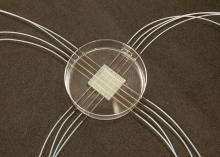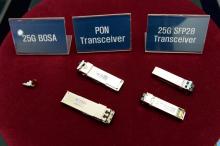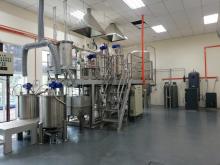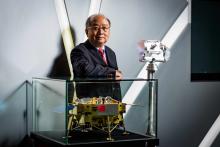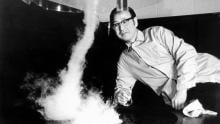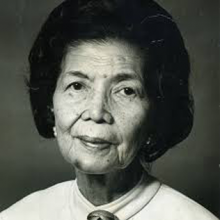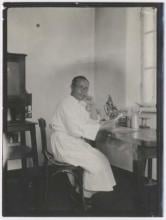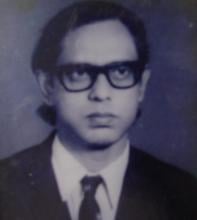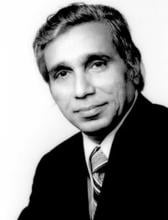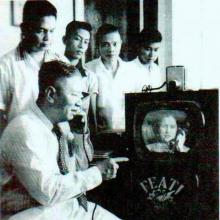Inventions
News

01 Feb 2019
The event showcased a curated list of 50 of the world’s most influential leaders and innovators who discussed how emerging technologies will influence industries related to artificial intelligence, robotics, sustainability, blockchain, bioengineering, social media, education, virtual reality, and 3D printing.

23 Jan 2019
A student, affiliated with South Korea's Ulsan National Institute of Science and Technology (UNIST) has been named a winner of the 2018 prestigious “Red Dot Award” for design concept.
17 Jan 2019
HKBU scholars invented the world’s first multidimensional antimicrobial susceptibility testing system. The new technology can provide information about drug resistant pathogens present in patients, enabling doctors to accurately determine the effectiveness and appropriate dosage of antibiotics needed for effective treatment.
16 Jan 2019
Researchers in South Korea have developed extremely fast information processing technologies that can help usher in the next generation of the Internet.
05 Jan 2019
Materials scientist and physicist Dr Tuomo Suntola, who recently won the Millennium Technology Prize 2018 for his invention of atomic layer deposition (ALD), will be participating in the Global Young Scientists Summit (GYSS) 2019 in Singapore, 20-25 January 2019.
13 Dec 2018
The present invention provides a method to produce black iron oxide nanoparticle slurry having a magnetite structure and homogenously disperse. It can be used as formed or mix with other medium.
10 Dec 2018
The Hong Kong Polytechnic University (PolyU) proudly supports the nation’s current lunar exploration, Chang’e-4 lunar probe, with advanced technologies.

10 Dec 2018
Do You Know How 3D Printing Will Disrupt the Future of Construction?

04 Dec 2018
UNIMAKER is the first step of having Maker's movement within universities campus environment. The event focuses on disruptive ideas and innovative solutions for the 4th Industrial Revolution (4IR), and is designed to bring researchers, innovators and developers from academia and industry to ideate next emerging technology.

28 Nov 2018
Meet the Innovators Changing our World
27 Nov 2018
A compound made from the glycerol by-product of biodiesel production could promote cleaner burning in vehicle engines.

22 Nov 2018
For the first time since its inception, Singaporean researchers were not listed.

22 Nov 2018
See you next year Shenzhen!

19 Nov 2018
Where business, technology and innovation collide in MTE Innovation Marketplace!
Events
Sorry, no events coming up for this topic.
Researchers
Sorry, no researchers coming up for this topic.
Giants in history
Tetsuya Theodore Fujita (23 October 1920 – 19 November 1998) was a Japanese-American meteorologist who created the Fujita scale that classifies the strength of tornadoes based on damage to structures and vegetation.
Chinese biochemist Cao Tianqin (5 December 1920 – 8 January 1995) discovered the myosin light chain, a subunit of myosin, a protein crucial for muscle contraction.
Fe Villanueva del Mundo (27 November 1911 – 6 August 2011) was a Filipina paediatrician who founded the Philippines’ first paediatric hospital.
Minoru Shirota (April 23, 1899 – March 10, 1982) was a Japanese microbiologist who invented the popular fermented drink Yakult.
Wu Lien-teh (10 March 1879 – 21 January 1960) was a Malaysian-born doctor who invented a mask that effectively suppressed disease transmission. Winning the prestigious Queen’s Scholarship enabled Wu to become the first Chinese student to study medicine at the University of Cambridge.
Physicist Narinder Singh Kapany (31 October 1926 – 4 December 2020) pioneered the use of optical fibres to transmit images, and founded several optical technology companies. Born in Punjab, India, he worked at a local optical instruments factory before moving to London for PhD studies at Imperial College. There, he devised a flexible fibrescope to convey images along bundles of glass fibres.
The field of solid-state ionics originated in Europe, but Takehiko Takahashi of Nagoya University in Japan was the first to coin the term ‘solid ionics’ in 1967. ‘Solid-state ionics’ first appeared in 1971 in another of his papers, and was likely a play on ‘solid-state electronics’, another rapidly growing field at the time.
Charles Kuen Kao (Nov. 4, 1933 to Sept. 23, 2018) was an engineer who is regarded as the father of fibre optics. His work in the 1960s on long distance signal transmission using very pure glass fibres revolutionized telecommunications, enabling innovations such as the Internet.
Sir Jagadish Chandra Bose (30 November 1858 – 23 November 1937) was a scientist and inventor who contributed to a wide range of scientific fields such as physics, botany and biology.
Abdus Suttar Khan (c. 1941 – 31 January 2008) was a Bangladeshi engineer who spent a significant part of his career conducting aerospace research with NASA, United Technology and Alstom.
Fazlur Rahman Khan (3 April 1929 – 27 March 1982) was a Bangladeshi-American structural engineer and architect who invented the tube principle, which formed the basis for modern skyscraper design.
Gregorio Y. Zara (8 March 1902 – 15 October 1978) was a Filipino engineer and physicist best remembered for inventing the first two-way video telephone. Zara’s video telephone invention enabled the caller and recipient to see each other while conversing, laying the foundation for video-conferencing



